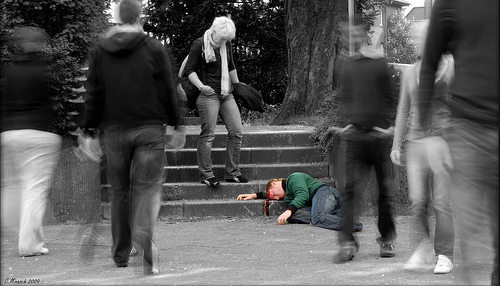BYSTANDERS: Kim Pham’s recent murder outside a Santa Ana nightclub shows the inability of society to react during emergency situations.
by Valeria Gutierrez, Staff Writer
All stories feature a prodigious hero or heroine. For the bookworms, Harry Potter and Katniss Everdeen changed the fate of the world within a few pages. For the historians, Tony Mendez, a U.S. Central Intelligence Agency (C.I.A.) exfiltration specialist, saved six politicians from a hostage situation during the Iranian Revolution in 1979. For those who love the classics, a palette surgeonfish named Dory assisted a clownfish she had just met named Marlin across the ocean to find his son Nemo. Three clumsy parapsychologists named Peter, Raymond and Egon joined forces against ghosts in 1984 to answer the famous question: “who you gonna call”? Disney’s hero Hercules started his legendary route to Mount Olympus with his first basic D.I.D. (Damsel in Distress). And let’s not forget one of America’s favorites: a below-average student who touched lives with the simple introduction, “My name is Forrest, Forrest Gump.”
We are naturally compelled to mimic our favorite characters’ admirable traits. Although a few heroes were created from a writer’s imagination, real heroes and heroines live every day, such as police officers, firefighters and doctors. While these professionals react quickly in emergency situations, not everyone has the ability to react so swiftly. Though a person might freeze when faced with danger, there is usually at least one person around to pull him or her to safety in the nick of time.
Unfortunately, for 23-year-old Kim Pham from California, not a single hero was out the night she decided to visit the popular Santa Ana nightclub, The Crosby. According to police, on January 18 around 12:20 a.m., Pham was beaten to death by a group of two men and three women when she accidently walked in front of a camera while the group was taking a picture. The police were able to identify the aggressors through the witnesses and footage that was taken of Pham while she was attacked until she was beaten brain dead. Oddly enough, the footage also shows a group of people who were in line to enter The Crosby surrounding Pham during the incident, and the security guard was reported to have arrived on the scene too late. Disturbingly, Pham was in line with her friends that night but they are nowhere to be seen on the video footage.
A famous case dealing with observed attacks and murders in which “good” civilians do nothing is the murder of Catherine Susan (Kitty) Genovese in 1964. Genovese lived in Brooklyn, New York and worked as a manager at the time of her mugging, rape and murder by Winston Moseley. Police reports state Genovese had just parked her car and was walking to her apartment nearby when Moseley attacked her. Genovese screamed out for help multiple times. Her neighbors ignored the cries and carried on with their night while the innocent 28-year-old was killed on their street. Neighbor Robert Mozer frightened the murderer by screaming to leave the girl alone but never left the safety of his apartment. Half an hour after the attack, all too late, Karl Ross made the call to the police. Once the story broke out, New York writers gave the incident the honest title “38 Who Saw Murder Didn’t Call the Police.”
The human behavior of “good” Samaritans doing nothing became known as the “bystander effect.” The bystander effect was researched intensively by John Darley and Bibb Latané in 1968. Darley and Latané concluded that witnesses in emergency situations go through the process of noticing the emergency, interpreting it, determining the degree of responsibility and form of assistance, and then finally executing their determined action. Through this process, the Average Joe has the capability of stepping in or deciding that the emergency taking place is not his problem. The research also found that when more civilians are around the situation, the less likely it is that each bystander is going to take action.
When middle and high school fights break out, the average teenager’s instinct is to form a crowd around the fight and pull his or her camera phone out to get the best shot. Adults have the same reaction in real-world circumstances. Instead of stopping the fight or making an attempt to save the victim, the average person will watch or carry on with his or her day and remain unaffected by the situation. But why? Is society afraid of receiving a black eye and few scrapes and bruises? Or are the people within society scared of what others might think of them? Regardless of what society thinks, no pride is worth watching someone murder a human being.
Who you become as a person starts in high school. If you stand around and watch a student suffer from a fight, you are just as capable of watching slaughter in the future. One person is all it takes to change a life. One person can create a domino effect of bystanders becoming heroes. Plenty of so-called “heroes and heroines” like to think they would take action in a life or death situation. However, the murders of Kim Pham and Catherine Genovese put such expectations into a harsher perspective.

